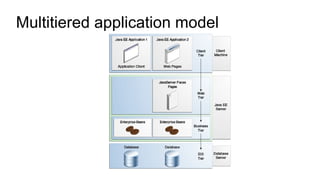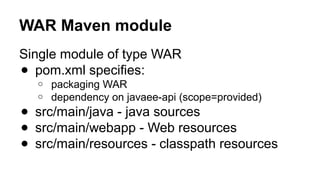Java EE web project introduction
- 1. Java EE Web project
- 2. Contents ● Java EE project setup ● Introduction to Maven ● Web application structure ● JSF basics ● CDI basics ● GIT overview (optional)
- 3. Java EE project setup in Eclipse Prerequisites: ● Eclipse Luna ● WildFly application server ● Maven support in Eclipse - m2eclipse ● Git support in Eclipse eGIT ● JBoss Tools for Eclipse ● Download prepared sources from GitHub
- 4. Java EE project setup in Netbeans Prerequisites: ● Netbeans 7 or 8 ● Glassfish application server ● Download prepared sources from GitHub
- 5. DEMO Presentation of the demo application in IDE and running on app server
- 6. Introduction to Maven ● project build and configuration tool ● it can: o execute build tasks using command line o automatically download necessary libriaries (dependencies) o configure project independently from IDE
- 7. Introduction to Maven - artifacts Artifacts are files produced by a maven build. They are specified by: ● groupId ● artifactId ● version ● packaging - JAR, WAR, EJB, EAR, POM, ... An artifact can be dependency of another module
- 8. Maven - goals and phases To execute maven build: > mvn goal Goal can be a name of phase that we want to complete. All phases before that phase are completed in order. The order of basic maven phases: compile, test, package, integration-test, install Steps to complete each phase may differ between module types (packging)
- 9. Maven - dependencies Specified by: groupId, artifactId, version, type (jar is default type) Scope of a dependency: ● compile (default) ● test - only used when running unit tests ● provided - not included in artifact
- 10. DEMO Example of Maven pom.xml. Example of running maven in IDE.
- 12. Java EE Web application In simplest for a single WAR file. ● WEB-INF folder o web.xml o faces-config.xml o optionally beans.xml for CDI o classes folder with compiled java classes ● web resources in root folder o JSF facelets, css, images, etc.
- 13. WAR Maven module Single module of type WAR ● pom.xml specifies: o packaging WAR o dependency on javaee-api (scope=provided) ● src/main/java - java sources ● src/main/webapp - Web resources ● src/main/resources - classpath resources
- 14. JSF overview ● run by FacesServlet mapped in web.xml ● configured by faces-config.xml and contex parameters in web.xml ● FacesServlet executes several phases in MVC style o Request -> Execute code in Java Bean -> Create view from Facelet -> Response
- 15. JSF lifecycle ● Restore view phase ● Apply request values phase; process events ● Process validations phase; process events ● Update model values phase; process events ● Invoke application phase; process events ● Render response phase
- 16. JSF Lifecycle
- 17. JSF component tree ● logical tree of UI components ● created from a definition in facelet ● encoded to xhtml at the end of the request o to bring new state of the view to browser (new page) ● recreated at the begining of the request o to represent the current state of the view before request is processed
- 18. JSF Facelets ● XHTML based templates for a web page ● define components in a component tree ● specify binding to Java code o data o conditional rendering o controller methods / listeners
- 19. JSF Managed Beans ● provide controller methods and data model for facelets ● bound to component properties using Expression Language ● identified in facelets by textual name ● marked by @Named CDI qualifier
- 20. Expression language EL is a script used in facelets to bind values to component properties ● Results in a value - primitive values, object, even a method pointer ● Fields are converted to getters and setters ● Never throws a Null Pointer -> blank value instead
- 21. Usage of Expression language ● enclosed in #{ ... } ● do not mix with ${ … } used in JSP o JSP and JSTL tags should not be mixed with JSF ● in facelet: rendered="#{ bookView.displayed } ● in BookView bean: @Named class BookView { public boolean isDisplayed() { return true; } }
- 22. Basic components - display ● h:outputText - textual output in <span> ● h:outputLabel - <label> ● h:outputLink - <a href…> ● h:messages - display of JSF messages ● h:graphicImage - <img> ● h:dataTable - table for collection of rows
- 23. Basic components - layout ● h:panelGroup - container - <span> or <div> ● h:panelGrid - grid layout container (table)
- 24. Basic components - Forms ● h:inputText ● h:inputTextarea ● h:selectManyListbox, h:selectOneMenu, etc. - selection components, listboxes, checkboxes ● h:form - all input components must be in some form to function
- 25. Basic components - actions ● All action components submit form and call action on web server via javascript ● They accept link to a listener method ● h:commandButton ● h:commandLink
- 26. Contexts & Dependency Injection ● Injection: instead of myVar = Factory.getVar() or myVar = new Var() declare that I need Var ● @Inject Var myVar ● instance of Var is created by the container ● works only in container managed beans o JSF beans, Servlets, EJBs, all injected beans - generally Java objects created by the container
- 27. Dependency injection rules ● never use “new” on a bean with a CDI dependency ● all injected beans must have constructor without parameters ● do not put initialization to constructor but to method marked with @PostConstruct
- 28. Lifecycle of injected beans ● when bean created o constructor is executed first o then are dependencies injected o method marked with @PostConstruct is called ● during injection, beans are either created or reused o it depends on current context of execution and scope of injected bean
- 29. Basic scopes ● Dependent (default) o a new bean is always created for injection o similar to calling constructor directly ● Application scope o single bean is created for whole application o the same bean is reused afterwards, retaining its complete state o singleton pattern
- 30. Basic Java EE scopes Most scopes are bound to a lifecycle of a specific action ● Request scope o bound to lifecycle of HTTP request o within HTTP request, only single instance of request scoped bean is created and reused ● Session scope o bound to lifecycle of HTTP session
- 31. Java EE scope annotations package javax.enterprise.context: ● Dependent (optional) ● ApplicationScoped ● RequestScoped ● SessionScoped Only single instance of Java object with defined scope is created and reused for single application, request, session
- 32. Dependency declaration ● inject by class o inject instance of the class or its subclass ● inject by interface o inject instance of java class with given interface ● inject by qualifier o inject instance with given qualifier o qualifier is a java annotation marked with @Qualifier For one injection point, one class should match
- 33. Runtime / conditional injection @Inject Instance<Var> myVarInjector; … myVar = myVarInjector.get(); ● matching bean is resolved when necessary ● can be injected directly when needed ● resolution errors can be treted at runtime
- 34. Creating new CDI beans ● possible to create a completely new CDI bean regardless of context ● @New annotation overrides bean scope ● can be used instead of new keyword: @Inject @New Instance<Var> varInjector; ...Var myVar1 = varInjector.get(); ...Var myVar2 = varInjector.get();
- 35. Producers ● CDI usually creates new beans via constructor without parameters ● Producers allow to customize creation ● instead of a class, a method of a producer is marked with annotations and scope o this method returns created bean of matching type o it is called when bean with the same definition is requested
- 36. Producers - example class MyVarProducer { @Produces @RequestScoped public Var createVar(@New Var var) { var.setState("NEW"); return var; } }
- 37. Introduction to GIT GIT is a source code version control system. It is a distributed version control system. ● multiple repositories can be interconnected and synchronized
- 38. GIT repository ● single instance of storage of versioned files ● stores latest version of files, history of changes, metadata (commit messages), and connection to other upstream repositories ● repositories are organized in a tree o from upstream repositories to downstream
- 39. Simplest GIT topology ● Central GIT repository - accesible via public link o local GIT repository o local GIT repository o local GIT repository ● Local repositories exist only on local computers o they are created from central using clone command
- 40. 2-step synchronisation ● clone - downloads new copy of repository ● edit files o add (add new files if created) o edited and removed files are already handled ● commit - save changes locally (checkpoint) ● pull - download changes from central repo o merge and resolve conflicting changes o commit if files changed ● push - upload locally commited changes








































